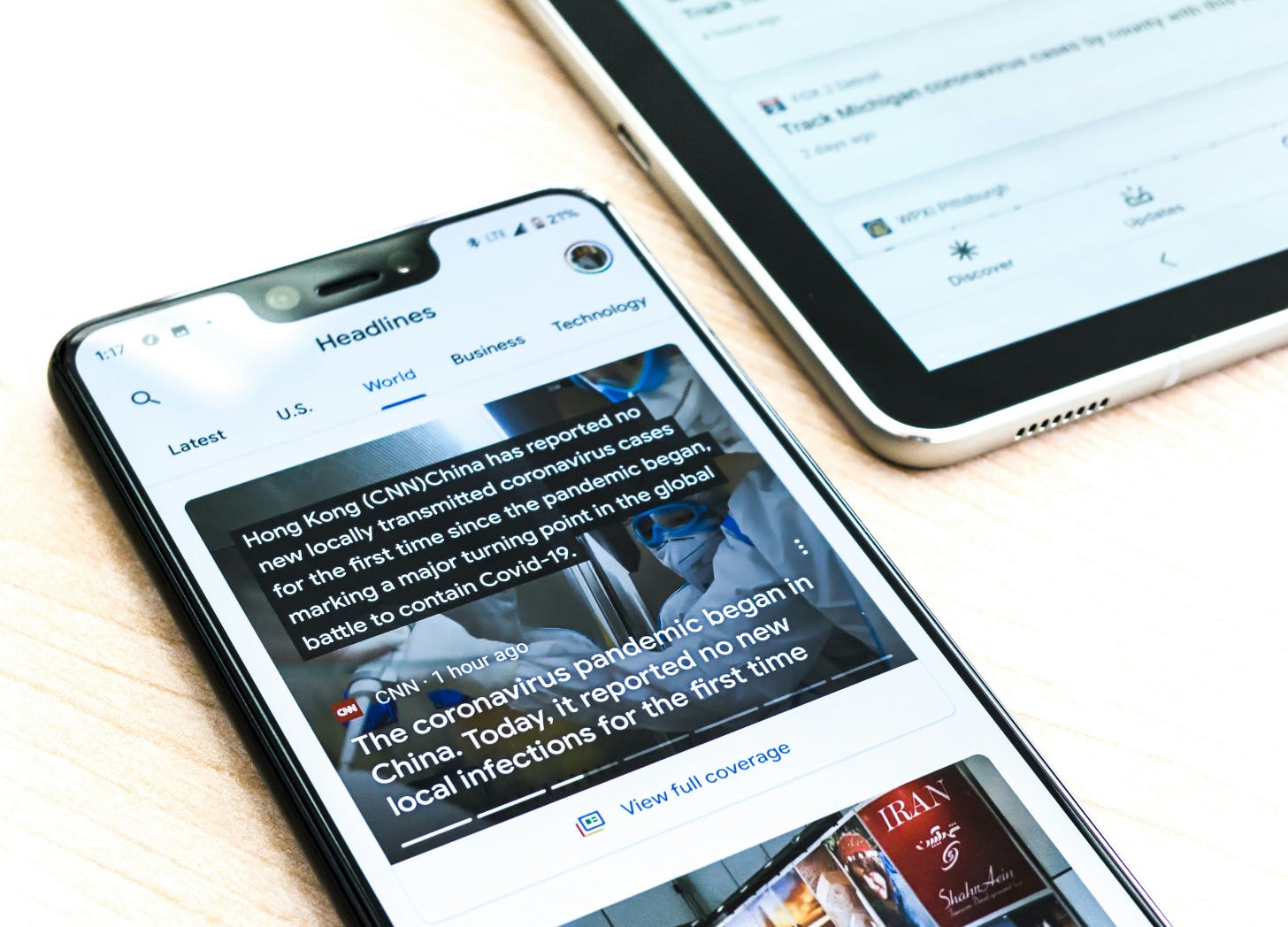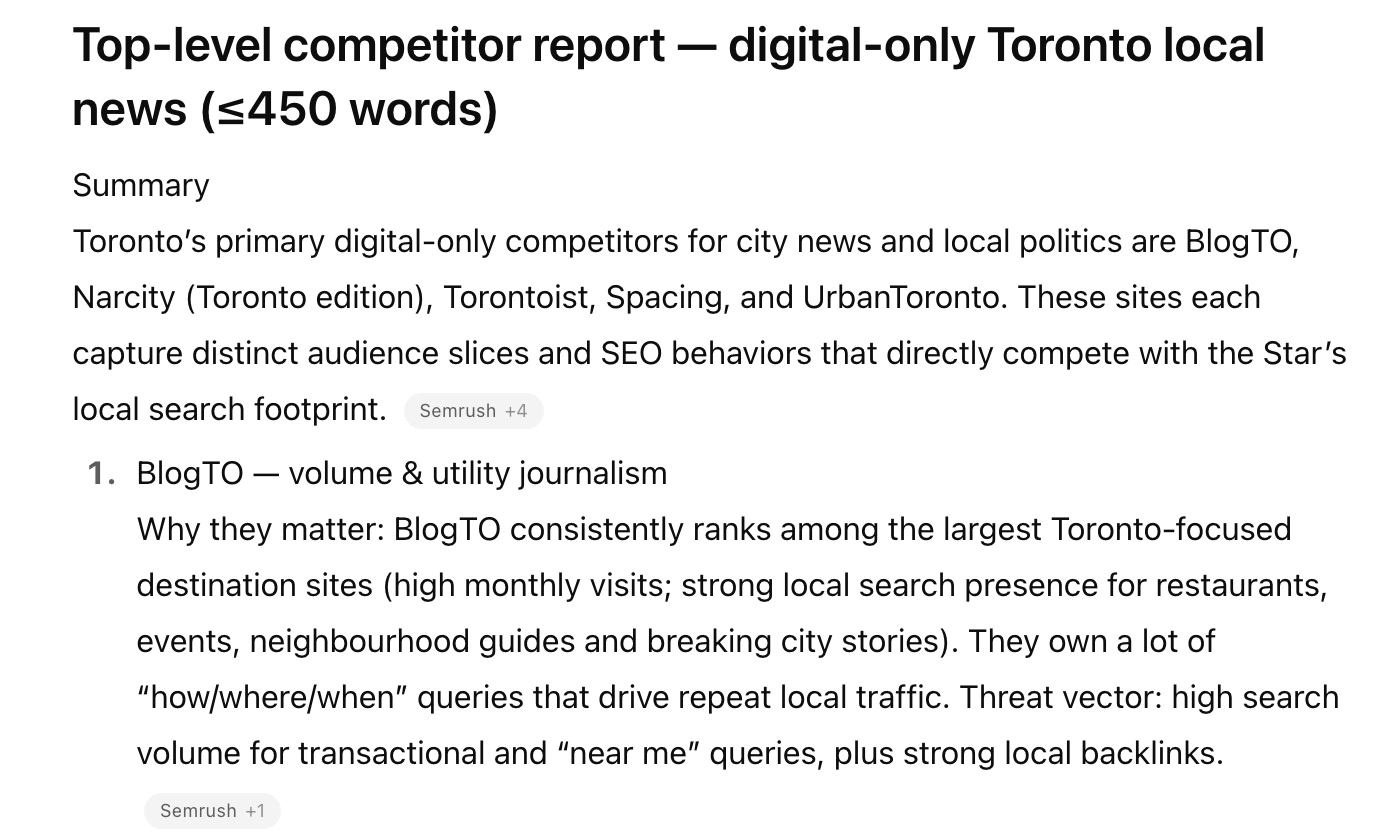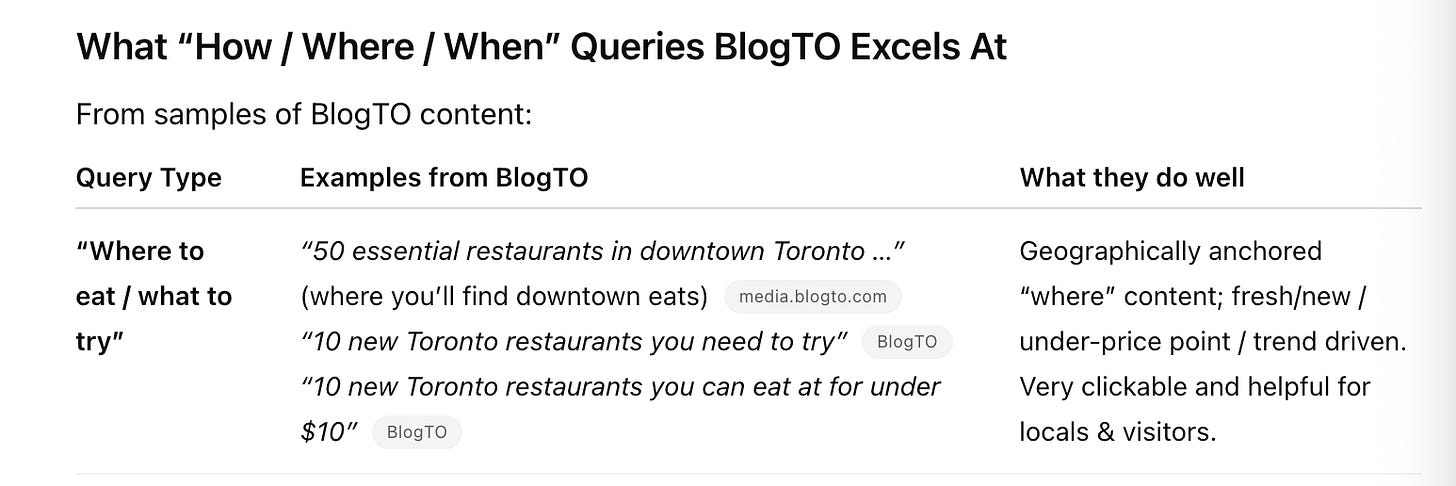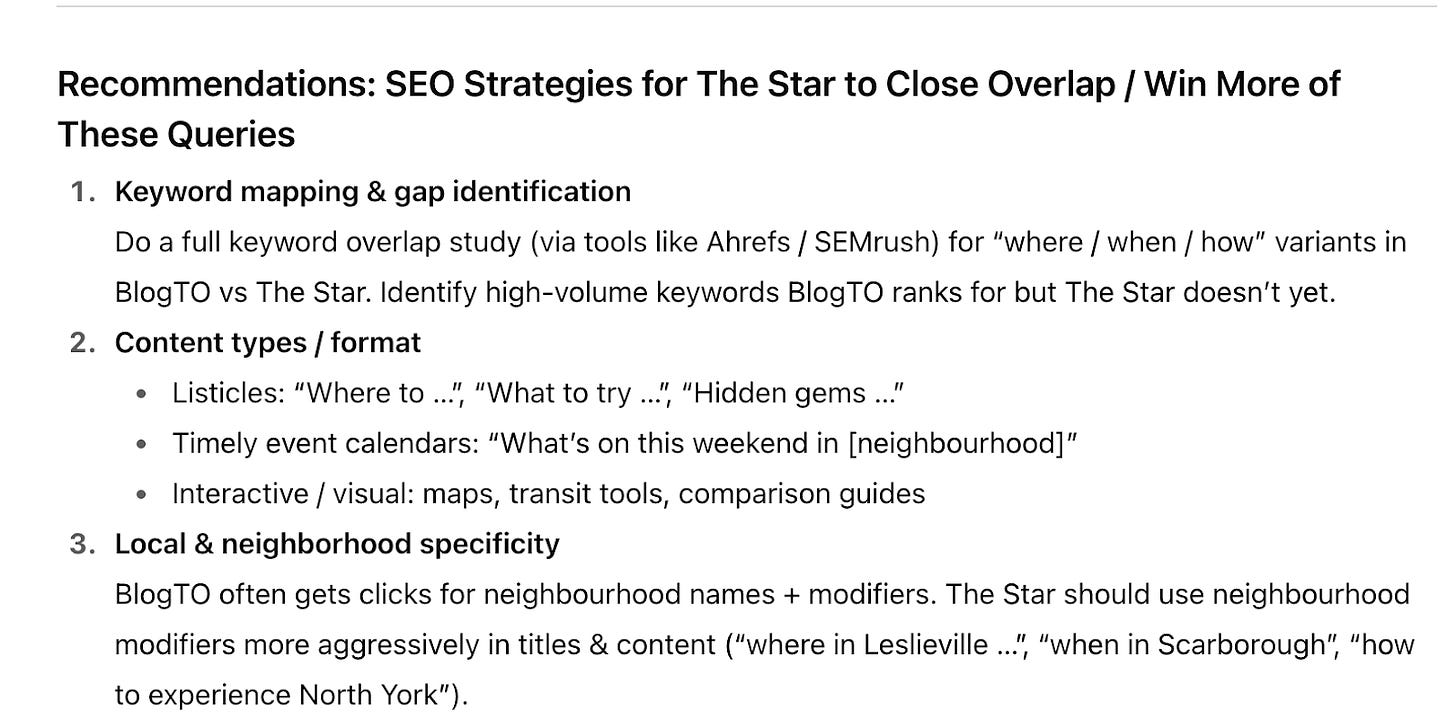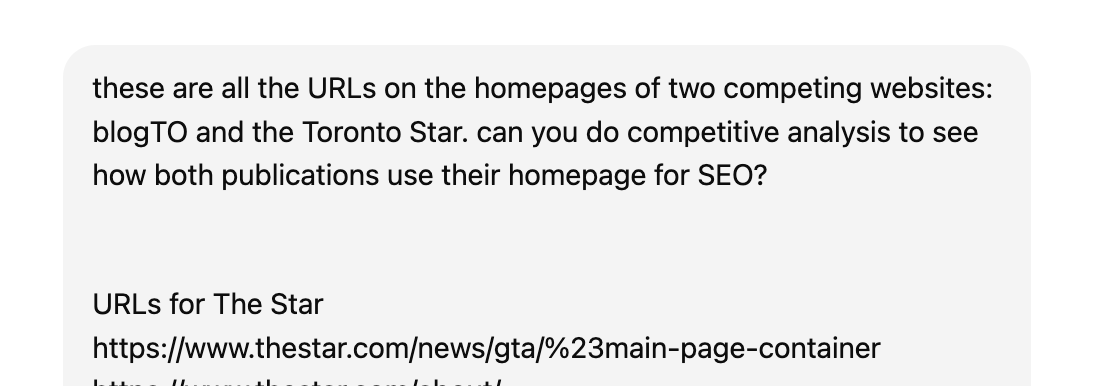ChatGPT for competitive analysis
How ChatGPT can help identify competitors, start analysis, wrangle data and review headline strategy.
#SPONSORED
Dive into historic AI Overview data with Trisolute News Dashboard!
Which keywords are consistently triggering Google AI Overviews over time? Track historic AIO trends now in the Trisolute News Dashboard to gauge impact and inform search optimization strategies.
Hello, and welcome back. Jessie here, back from a stunning early October weekend in Toronto, where the leaves are starting to turn and the pumpkin spice lattes are aplenty — but it’s still 23 degrees Celsius. Also this weekend: the last softball game of the season (a championship victory), the Brokes in concert (a Strokes cover band) and a crafty Sunday night.
This week: How to do competitive analysis with the help of ChatGPT. Competitive analysis is essential to know how your rivals are doing. Here’s how to use AI to identify competitors, start analysis, wrangle data and review headline strategy.
Join our community of news SEOs on Slack to chat any time.
Let’s get it.
THE HOW TO
Tips for doing competitive analysis with ChatGPT
News SEO and audience editors are busy. In-depth analysis about your competitors can feel like a nice-to-have and out of reach. But, with the rapid change we’re currently facing, it’s essential to know how others are adapting. Good news: AI can help.
ChatGPT can speed up the competitive analysis process and provide a high-level look at your profile versus other outlets in your niche.
🔥 Pro tip: Before you prompt, make a copy of Ahrefs or Moz templates for taking notes.
(Note: Before using any AI tool for this work, consult your editorial standards and /code of conduct. AI will get things wrong. Be mindful that all outputs should be carefully reviewed.
ChatGPT prompts to identify your competitors
Newsrooms know who their competitors are, but these are often editorially driven (i.e., a local outlet views another publication in the city as a rival). Readers — and Google and LLMs — might have a different view.
ChatGPT can help analyze and interpret the competitive landscape. It can help decode the coverage and positioning of rival publications, uncovering valuable insights into how it — based on Google’s index — sees the outlets.
Starting prompts could include:
Who are the biggest competitors for [publication name]?
Who are the biggest competitors within the vertical/niche of [a specific topic or keyword]?
What non-news publications are competing with [my publication] for visibility/ranking on search?
What are the top [digital/tv/radio/newsletter] publications focused on [general news or a specific niche] in [state/province/city]?
What are the pros and cons/benefits and disadvantages of these publications? Return as a table.
What is [the publication’s] brand value that can be leveraged on search/social/the homepage?
How do I take action on the above right now in 3 bullet points?
How does [publication] build its topic authority on search and on AI platforms?
Give me reasons why [publication] can’t keep up with [competitor(s)]. Return as a table.
In the example above, the prompt returns a table of competing publications with an estimate of the site’s monthly traffic and visits. (Fact-check these numbers in an SEO tool like Similarweb, Semrush or Ahrefs.)
Specificity in prompts is critical. The more information you give to the robot, the better the AI initially does at providing useful information.
The above prompt is pretty broad. It could be expanded (following Yumi Wilson’s recommendations) to include:
More precision by adding a scope for the output (i.e., a top-level analysis of the market in a chart);
More context, like who the output is for (i.e., senior editors who are not familiar with SEO);
A role/persona for the AI to embody (i.e., an SEO and audience editor);
Clarity on how the AI should write/format the response (i.e., word count or format like a table);
That revised prompt could look like:
You are a news SEO editor working for the Toronto Star. You’ve been tasked with writing a top-level report (no more than 450 words) that outlines your main search competitors for general news coverage. What are the top digital-only publications focused on city news/local politics in Toronto?
The output above offers more nuance and ideas for data points to include in a report (i.e., monthly site visits or backlinks). It also offers content areas to analyze further (i.e., a strength of BlogTO is that it owns local “how/where/when” queries).
ChatGPT is a conversational interface, so have a conversation with it. Start with a broad prompt, then revise to ask for more specifics. For example, a further prompt to the above could be:
“Now, provide a keyword overlap audit for BlogTO on [five priority how/where/when keywords] compared to my site.”
ChatGPT returned three sections of analysis:
The how/where/when queries that BlogTO owns.
The keyword gaps between BlogTO and The Star, along with opportunities for The Star to explore.
Additional SEO recommendations to reclaim rankings.
This is a starting point for your analysis. From here, go outside of ChatGPT. Using your notes and insights, look at your site and compare it to your competitors. Where does the content fall short? What are areas to expand?
Supplement this analysis with data from SEO tools. For example, to size up the search opportunity on how/where/when keywords, use a tool to get search volume estimates for sample terms.
ChatGPT prompts for working with data
ChatGPT can also be very useful for data wrangling. The robots can help extract data from a URL (or multiple URLs) for further analysis. Look for semantic clues in the URL — such as if it includes /live/ for a blog, or /review/ for an affiliate article — as a way of categorizing the kind of story published on that page.
🔥 Pro tip: Consult OpenAI’s blog post for how to work with AI and data.
For example, if you want to analyze a competitor’s homepage as a sample set for how the publication approaches coverage, ChatGPT can help.
The homepage is your most powerful page for SEO; links from this page carry the most weight. ChaptGPT can help with top-level understanding of how other sites use that to their benefit.
Using the Links functionality in SEO Pro Chrome extension, export all the URLS on a homepage. Upload this data to ChatGPT for analysis.
Here, the prompt returns top-level information about the URLs and how both sites are making use of the homepage.
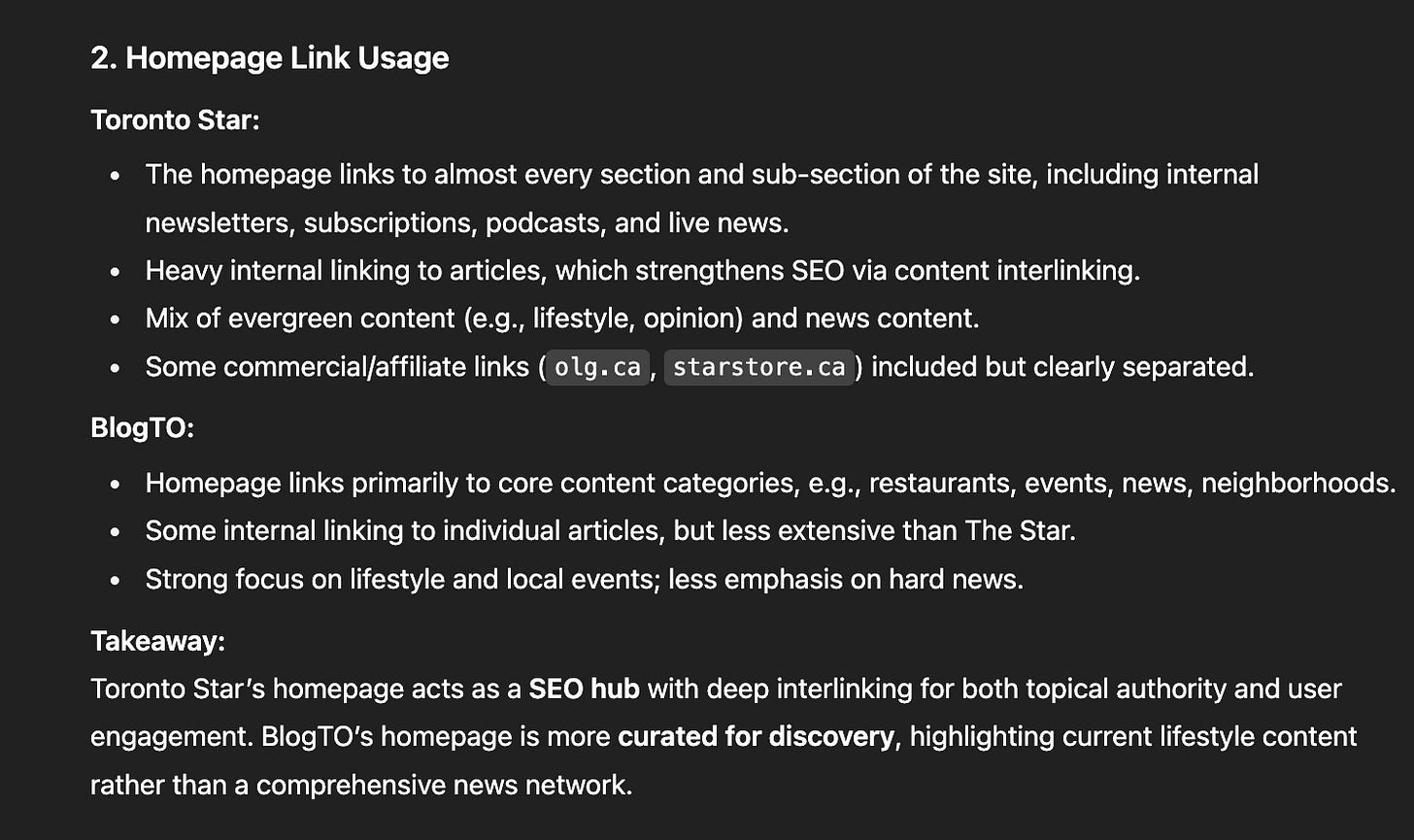
ChatGPT prompts for analysis of headlines
Headlines are the most important information on a page, both to convince a reader to click and for SEO. ChatGPT can be used to start the analysis of the most engaging headlines and best practices.
Prompts to get started:
I have uploaded a sample set of headlines for [X publication] and [Y publication]. Analyze both sets of headlines and headline structure. What headlines are the most engaging and why? What are the headline strengths and weaknesses of both publication’s approaches to headline writing?
Which headlines perform best from the content already? As an SEO and audience editor, what are some actionable suggestions to improve your efforts?
ChatGPT returns a table with multiple sections from the initial prompt asking for analysis of a sample of headlines.
An overview table comparing style and tone for headlines on both sites.
A table reviewing the headline structure, which can be a jumping off point for developing best practices and discussing with editors.
What ChatGPT views as the most engaging options, including notes about why it works.
Review the suggestions, identifying the useful headline framing devices employed by other outlets.
Note: BlogTO — like many other publications — have blocked OpenAI from crawling their site, so there are restrictions to what ChatGPT can analyze. To circumvent this, extract a list of headlines, then upload the data directly to ChatGPT (as long as legal and acceptable in your newsroom).
The bottom line: Competitive analysis is essential, but time-consuming and strenuous. ChatGPT can help speed up the process and unveil top-level insights that can be critical to standing out from the crowd.
#SPONSORED - The Classifieds
Get your company in front of more than 13,000 writers, editors and digital marketers working in news and publishing. Sponsor the WTF is SEO? newsletter!
RECOMMENDED READING
Google news and updates
🤖 Barry Schwartz: Google’s AI Mode has been updated to be more visual in how it handles and responds to users.
🤖 Barry Schwartz: Google tests the layout for citations in AI Overview as users scroll through results.
🎤 Anirban Chowdhury: Corner office conversation with Google’s head of Search, Elizabeth Reid [video].
Even more recommended reading
🛍️ OpenAI: The company has announced Instant Checkout, a step toward agentic commerce in ChatGPT.
🔗 Despina Gavoyannis: “Brand mentions are to AI search what backlinks are to traditional SEO.”
🖇️ Kevin Indig: How AI really weighs links.
🛒 Andrea Volpini: From catalogs to conversations in OpenAI’s product feeds.
🚨 Matt Southern: Microsoft launched a new Bing Places for businesses.
🧠 Kirsten Eddy: Pew Research Center found that Americans have mixed feelings about AI summaries in search results.
What did you think of this week’s newsletter?
(Click to leave feedback.)
Catch up: Last week’s newsletter
Have something you’d like us to discuss? Send us a note on Twitter (Jessie or Shelby) or to our email: seoforjournalism@gmail.com.
Written by Jessie Willms and Shelby Blackley




